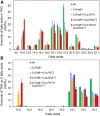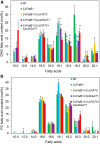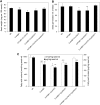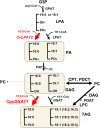A Specialized Diacylglycerol Acyltransferase Contributes to the Extreme Medium-Chain Fatty Acid Content of Cuphea Seed Oil
- PMID: 28325847
- PMCID: PMC5411140
- DOI: 10.1104/pp.16.01894
A Specialized Diacylglycerol Acyltransferase Contributes to the Extreme Medium-Chain Fatty Acid Content of Cuphea Seed Oil
Abstract
Seed oils of many Cuphea sp. contain >90% of medium-chain fatty acids, such as decanoic acid (10:0). These seed oils, which are among the most compositionally variant in the plant kingdom, arise from specialized fatty acid biosynthetic enzymes and specialized acyltransferases. These include lysophosphatidic acid acyltransferases (LPAT) and diacylglycerol acyltransferases (DGAT) that are required for successive acylation of medium-chain fatty acids in the sn-2 and sn-3 positions of seed triacylglycerols (TAGs). Here we report the identification of a cDNA for a DGAT1-type enzyme, designated CpuDGAT1, from the transcriptome of C. avigera var pulcherrima developing seeds. Microsomes of camelina (Camelina sativa) seeds engineered for CpuDGAT1 expression displayed DGAT activity with 10:0-CoA and the diacylglycerol didecanoyl, that was approximately 4-fold higher than that in camelina seed microsomes lacking CpuDGAT1. In addition, coexpression in camelina seeds of CpuDGAT1 with a C. viscosissima FatB thioesterase (CvFatB1) that generates 10:0 resulted in TAGs with nearly 15 mol % of 10:0. More strikingly, expression of CpuDGAT1 and CvFatB1 with the previously described CvLPAT2, a 10:0-CoA-specific Cuphea LPAT, increased 10:0 amounts to 25 mol % in camelina seed TAG. These TAGs contained up to 40 mol % 10:0 in the sn-2 position, nearly double the amounts obtained from coexpression of CvFatB1 and CvLPAT2 alone. Although enriched in diacylglycerol, 10:0 was not detected in phosphatidylcholine in these seeds. These findings are consistent with channeling of 10:0 into TAG through the combined activities of specialized LPAT and DGAT activities and demonstrate the biotechnological use of these enzymes to generate 10:0-rich seed oils.
© 2017 American Society of Plant Biologists. All Rights Reserved.
Figures










Similar articles
-
Structurally divergent lysophosphatidic acid acyltransferases with high selectivity for saturated medium chain fatty acids from Cuphea seeds.Plant J. 2015 Dec;84(5):1021-33. doi: 10.1111/tpj.13063. Plant J. 2015. PMID: 26505880
-
Toward production of jet fuel functionality in oilseeds: identification of FatB acyl-acyl carrier protein thioesterases and evaluation of combinatorial expression strategies in Camelina seeds.J Exp Bot. 2015 Jul;66(14):4251-65. doi: 10.1093/jxb/erv225. Epub 2015 May 11. J Exp Bot. 2015. PMID: 25969557 Free PMC article.
-
Two Acyltransferases Contribute Differently to Linolenic Acid Levels in Seed Oil.Plant Physiol. 2017 Apr;173(4):2081-2095. doi: 10.1104/pp.16.01865. Epub 2017 Feb 24. Plant Physiol. 2017. PMID: 28235891 Free PMC article.
-
Camelina sativa: An ideal platform for the metabolic engineering and field production of industrial lipids.Biochimie. 2016 Jan;120:9-16. doi: 10.1016/j.biochi.2015.06.009. Epub 2015 Jun 21. Biochimie. 2016. PMID: 26107412 Review.
-
Properties and Biotechnological Applications of Acyl-CoA:diacylglycerol Acyltransferase and Phospholipid:diacylglycerol Acyltransferase from Terrestrial Plants and Microalgae.Lipids. 2018 Jul;53(7):663-688. doi: 10.1002/lipd.12081. Epub 2018 Sep 25. Lipids. 2018. PMID: 30252128 Review.
Cited by
-
Integrated transcriptome and metabolome analyses reveal the differentially expressed metabolites and genes involved in lipid in olive fruits.PeerJ. 2025 Feb 17;13:e18941. doi: 10.7717/peerj.18941. eCollection 2025. PeerJ. 2025. PMID: 39981043 Free PMC article.
-
Integrative lipidomics profile uncovers the mechanisms underlying high-level α-linolenic acid accumulation in Paeonia rockii seeds.Hortic Res. 2023 May 15;10(7):uhad106. doi: 10.1093/hr/uhad106. eCollection 2023 Jul. Hortic Res. 2023. PMID: 37577394 Free PMC article.
-
Genetic dissection of QTLs for oil content in four maize DH populations.Front Plant Sci. 2023 Apr 12;14:1174985. doi: 10.3389/fpls.2023.1174985. eCollection 2023. Front Plant Sci. 2023. PMID: 37123853 Free PMC article.
-
Medium-chain triglyceride production in Nannochloropsis via a fatty acid chain length discriminating mechanism.Plant Physiol. 2022 Oct 27;190(3):1658-1672. doi: 10.1093/plphys/kiac396. Plant Physiol. 2022. PMID: 36040196 Free PMC article.
-
Evolution of a plant gene cluster in Solanaceae and emergence of metabolic diversity.Elife. 2020 Jul 2;9:e56717. doi: 10.7554/eLife.56717. Elife. 2020. PMID: 32613943 Free PMC article.
References
-
- Bafor M, Stymne S (1992) Substrate specificities of glycerol acylating enzymes from developing embryos of two Cuphea species. Phytochemistry 31: 2973–2976
-
- Bates PD. (2016) Understanding the control of acyl flux through the lipid metabolic network of plant oil biosynthesis. Biochim Biophys Acta 1861(9 Pt B): 1214–1225 - PubMed
MeSH terms
Substances
LinkOut - more resources
Full Text Sources
Other Literature Sources

